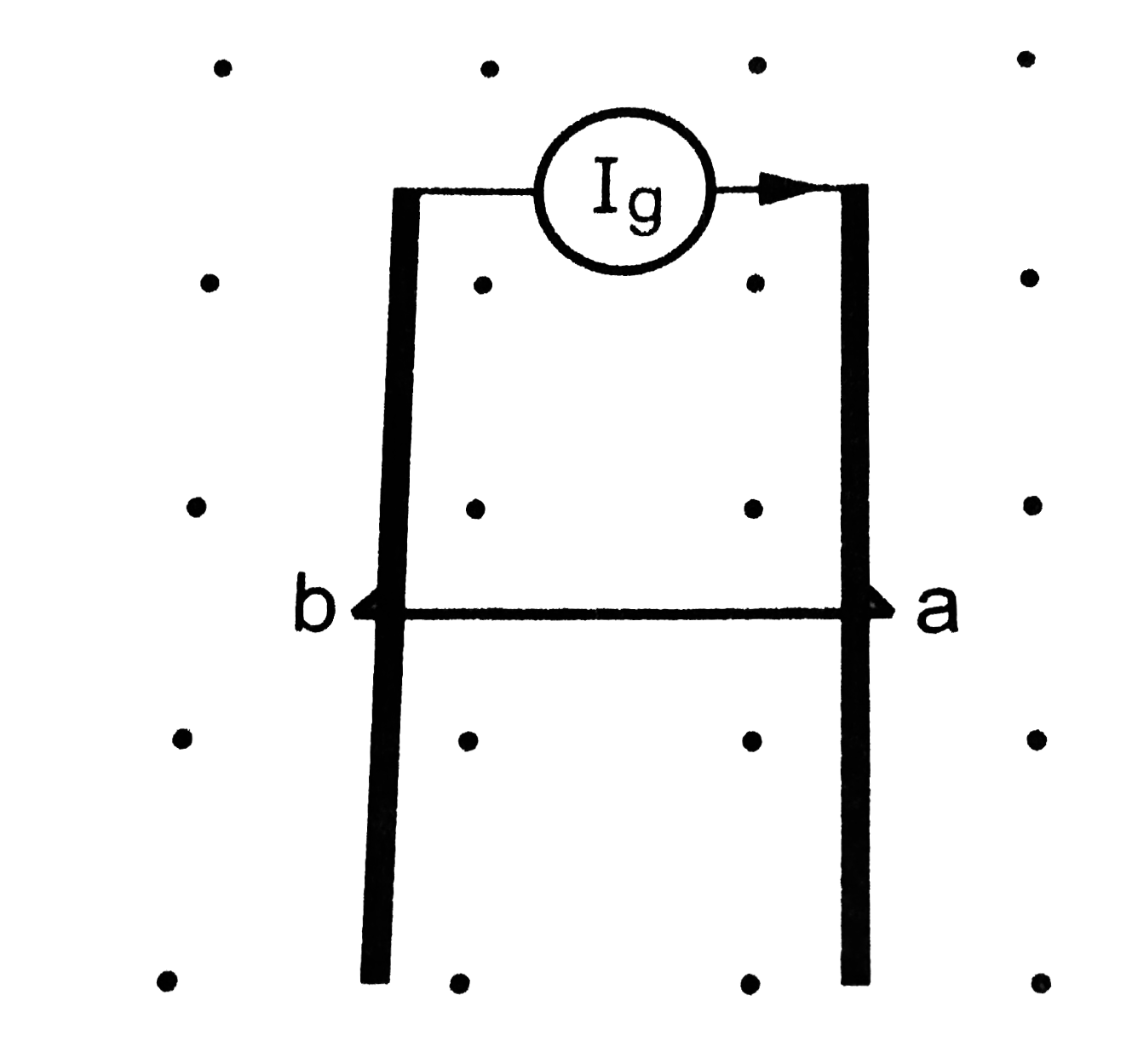The system containing the rails and the wire of the previous problem is kept vertically in a uniform horizontal magnetic field B that is perpendicular to the plane of the rails. It is found that the wire stays in equilibrium. If the wire ab is replaced by another of double its mass, how long will it take in falling through a distance equal ot its length?

Given : Blv=mg
When wire is replace ,we have
2mg−Blv=2ma…(i)
⇒a=2mg−Blv2m
Now,s=ut+(12)at2
⇒l=(12)×2mg−Blv2m×t2
[∴S=l]
t=√4ml2mg−Blv
=√4ml2mg−mg[om(1)]
=√21g.
Topper's Solved these Questions
- ELECTROMAGNETIC INDUCTIONBook:HC VERMAChapter:ELECTROMAGNETIC INDUCTIONExercise:EXERCISE
Explore 9 Videos
- ELECTROMAGNETIC INDUCTIONBook:HC VERMAChapter:ELECTROMAGNETIC INDUCTIONExercise:Objective 2
Explore 10 Videos
- ELECTRIC FIELD AND POTENTIALBook:HC VERMAChapter:ELECTRIC FIELD AND POTENTIALExercise:Exercises
Explore 75 Videos
- ELECTROMAGNETIC WAVESBook:HC VERMAChapter:ELECTROMAGNETIC WAVESExercise:Exercises
Explore 9 Videos
Similar Questions
Figure shows a wire ab of length L and resistance R which can slide on a smooth pair of rails. Ig is current generator which supplies a constant current i in the circuit. If the wire ab slide at a speed v towards right, find the potential difference below a and b

(b) The current generator Ig show in the figure sends a constant current i through the circiut. The wire ab has a length L and mass m and can slide on the smooth horizontal rails connect to Ig . The entire system lies in a vertical magnetic field B . Find the velocity of the wire as a function of time.

(c) The system containing the rails and the wire of the previous part is kept vertically in a uniform horizontal magnetic field B that is perpendicular to the plane of the rails (figure). If is found that the wire stays in equilibrium. If th ewire ab is replaced by another wire of double its mass, how long will lit take in falling through a distance equal to its length?
The current generator Ig shown in figure sends a constant current i through the circuit. The wire cd is fixed and wire ab is made to slide on the smooth, thick rails with a constant velocity v toward right. Each of these wires has resistance r . Find the current through the wire cd .

View SolutionA light freely deformable conducting wire with insulation has its two ends (A and C) fixed to the ceiling. The two vertical parts of the wire are close to each other. A load of mass m is attached to the middle of the wire. The entire region has a uniform horizontal magnetic field B directed out of the plane of the figure. Prove that the two parts of the wire take the shape of circular arcs when a current I is passed through the wire. Neglect the magnetic interaction between the two parts of the wire.

View Solution
Knowledge Check
A circular wire loop of radius r lies in a uniform magnetic field B, with its plane perpendicular to magnetic field. If the loop is deformed to a square shape in the same plane in time t, the emf induced in the loop is
AπBr2t(1−π2)BπBr2t(1−π3)CπBr2t(1−π4)DπBr2t(1−π5)An elastic circular wire of length 1 carries a current 1. It is placed in a uniform magnetic field B (out of paper) such that its plane is perpendicular to the direction of B. The wire will experience
 Ano forceBa stretching forceCa compressive forceDa torque
Ano forceBa stretching forceCa compressive forceDa torqueStatement I: A resistance R is connected between the two ends of the parallel smooth conducting rails. A conducting rod lies on these fixed horizontal rails and a uniform constant magnetic field B exists perpendicular to the plane of the rails as shown in Fig. if the rod is given a velocity υ and released as shown in Fig. 3.188, it will stop after some time. the total work done by magnetic field negative.

Statement II: If force acts opposite to direction of velocity its work done is negative.A(a) Statement I is True, Staatement II is True, Statement II is correct expaination for Statement I.B(b) Statement I is True, Staatement II is True, Statement II is NOT a correct expaination for Statement I.C( c) statement I is True, Satement II is false.D( d) statement I is False, Satement II is True.
A copper wire bent in the shape of a semicircle of radius r translates in its plane with a constant velocity v. A uniform magnetic field B exists in the direction perpendicular to the plane of the wire. Find the emf induced between the ends of the wire if (a) the velocity is perpendicular ot the diameter joining free ends, (b) the velocity is parallel to this diameter.
View SolutionAn elastic circular wire of length l carries a current I. It is placed in a uniform magnetic field →B (Out of paper) such that its plane is perpendicular to the direction of →B. The wire will experience

View SolutionA conducting wire xy of lentgh l and mass m is sliding without friction on vertical conduction rails ab and cd as shown in figure. A uniform magnetic field B exists perpendicular to the plane of the rails, x moves with a constant velocity of

View SolutionA 2.5 m long straight wire having mass of 500 g is suspended in mid air by a uniform horizontal magnetic field B. If a current of 4 A is passing through the wire then the magnitude of the field is (Take g 10ms−2)
View SolutionA loop of flexible conducting wire lies in a magnetic field of 2.0 T with its plane perpendicular to the field. The length of the wire is 1 m. When a current of 1.1A is passed through the loop, it opens into a circle, then the tension developed in the wire is
View Solution